Plants Make Life Better
With the big worries of today, it’s important to find joy in the little things. Even if it sometimes feels hard to breathe and your financial worries are keeping you up at night, finding something to make you smile can make everything seem OK.
For every day we continue to feel overwhelmed and can’t seem to focus, Plant Something Oregon wants you to know that simple comforts are growing all around us, in the form of plants, trees and gardens. More often than not, they may provide an unexpected pick-me-up, but there are statistics and case studies to back up the notion that plants just make life better. Are you worried about the rise of domestic crime in your community? Or heating and cooling costs? Plants have a solution to that — and the research proves it.
Check out the information below and help share the word: Plants make life better.
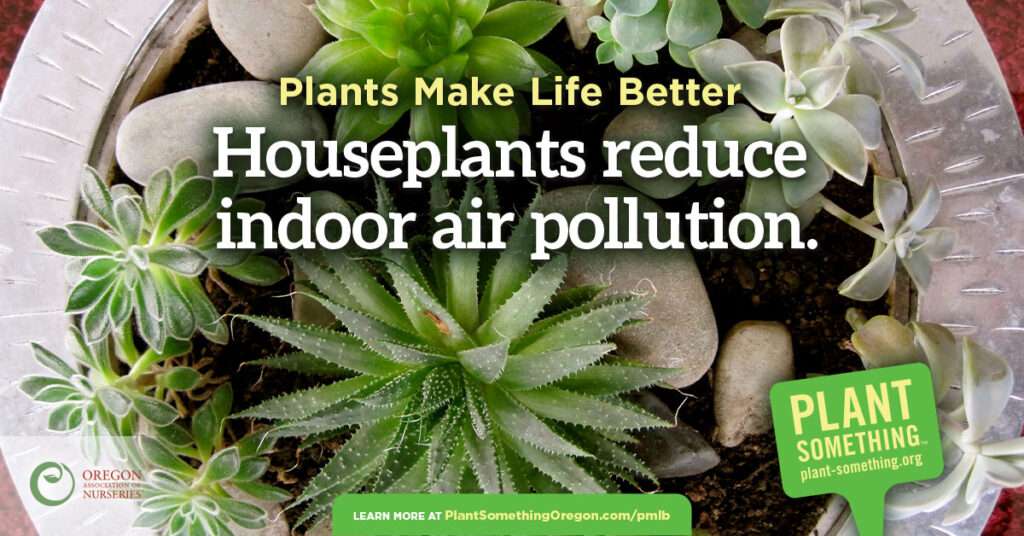
Houseplants reduce indoor air pollution
- Indoor air pollution is “one of the world’s greatest public health risks,” according to studies reported in HortTechnology1. In fact, indoor “smog” is an even bigger problem than outdoor smog.
- Unhealthy indoor air with volatile organic compounds, ozone and other pollutants causes serious health problems, cuts into worker productivity and drives up medical costs.
- What can we do to clear the air? Houseplants provide a cost-effective solution. Houseplants can remove pollutants and return oxygen to the air. They also produce positive, aesthetic effects and boost the well-being of workers.
- Studies2 show that most leafy plants are adept at purifying indoor air, but some plants are especially good at removing volatile organic compounds.
- According to one study3, Japanese royal ferns, spider plants, Boston ferns, purple waffle plants, English ivy, areca palms, golden pothos, aloe vera, snake plants and peace lilies all excel at reducing indoor air pollution.
SOURCES:
1 Papinchak, Heather L., Holcomb, E. Jay, Best, Teodora Orendovici, Decoteau, Dennis R. Effectiveness of Houseplants in Reducing the Indoor Air Pollutant Ozone.HortTechnology, 2009 19: 286-290
2Can ornamental potted plants remove volatile organic compounds from indoor air? — a review. Majbrit Dela Cruz & Jan H. Christensen & Jane Dyrhauge Thomsen & Renate Müller Springer-Verlag Berlin Heidelberg 2014
3https://goo.gl/ef1OkD
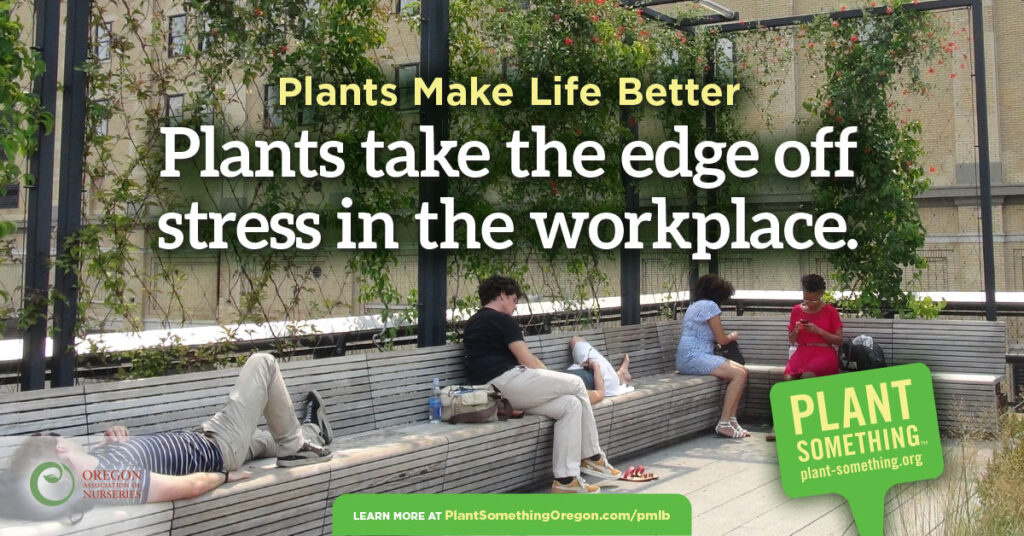
Plants take the edge off stress in the workplace
- Many of the benefits plants offer people have to do with the ability to maintain high levels of concentration and creative thinking at work and school.
- Forty years of research compiled by the University of Washington Urban Forestry/Urban Greening Research Department1 show that having living plants inside and out can alleviate mental fatigue and sharpen focus on tasks.
- The positive connection to nature is so potent that simply having views of the natural world from windows can “help reduce stress, boost productivity, improve job satisfaction, and help workers stay more attentive,” according to one report.2
- Plants in work environments also benefit workers by producing “improved employee morale, decreased absenteeism, and increased worker efficiency.”3
- In addition, research at Texas A&M University found “an increase in innovative thinking, creative performance and problem solving with the presence of plants and flowers in the workplace.”
SOURCES:
1depts.washington.edu/hhwb
2Berto, R. 2005. Exposure to Restorative Environments Helps Restore Attentional Capacity. Journal of Environmental Psychology 25, 3:249-259.
3Shibata, S., and N. Suzuki. 2002. Effects of the Foliage Plant on Task Performance and Mood. Journal of Environmental Psychology 22, 3:265-272
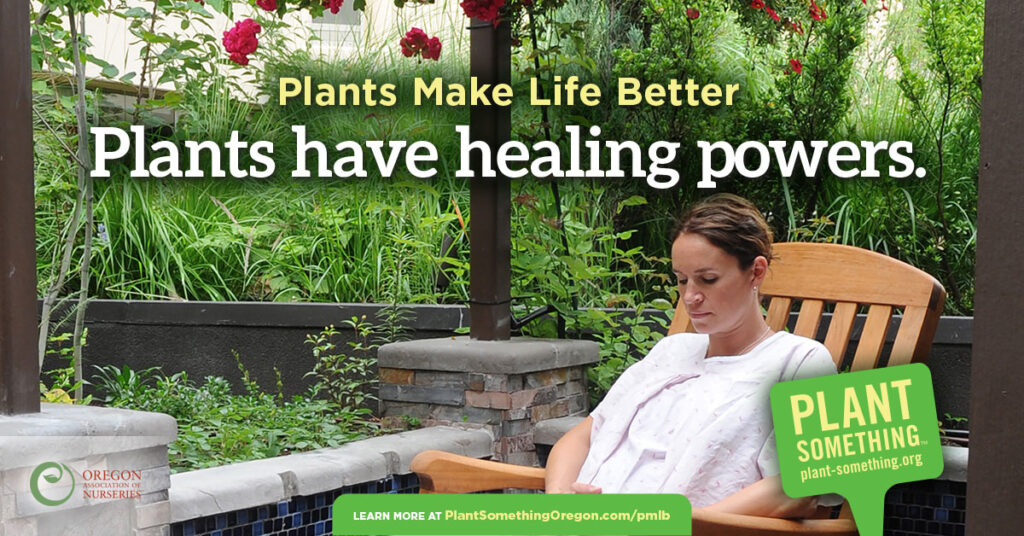
Plants have healing powers
- When someone is sick or recovering from surgery, loved ones frequently send flowers or plants. But do plants actually help people feel better? Research proves they do.
- In fact, plants and flowers have powerful healing properties. Any exposure to nature, even viewing landscape from windows, makes people feel better and heal more quickly.
- Studies conducted in health care settings show that exposure to nature promotes healing, both physiologically and mentally.1 Having plants in patient recovery rooms reduces the time needed for healing.
- Flowers and plants are so soothing that even passive exposure to nature promotes healing and “can significantly speed up recovery time.”2
- Hospital patients with plants in their rooms display less fatigue and pain, shorter hospital stays, less anxiety, and higher hospital and room satisfaction, according to another study.3
The Terrace Garden at Legacy Emanuel Medical Center in Portland, Oregon, serves birthing moms, cardiovascular ICU patients, families and employees. Photo courtesy of Legacy Health
SOURCES:
1Kuo, F.E., and W.C. Sullivan. 2001. Environment and Crime in the Inner City: Does Vegetation Reduce Crime? Environment and Behavior 33, 3:343–367.
2Lorenzo, A.B., and D. Wims. 2004. Do Designed Landscapes Deter Crime? Proceedings of the Florida State Horticultural Society 117:297–300.
3Donovan, G.H, and J.P. Prestemon. 2012. The Effect of Trees on Crime in Portland, Oregon. Environment and Behavior 44, 1:3–30
Green Cities, Good Health, http://depts.washington.edu/hhwb

Landscaping boosts property values
- Landscaping produces real economic returns for both residential and commercial properties. One study1 shows that for every $1 invested in plants, property values increase an average of $1.09 — a yield that beats other property improvements.
- Curb appeal from professionally designed landscapes and lawns leads potential homebuyers to perceive higher property values, which can produce a significant return on investment.
- Businesses featuring aesthetically pleasing, landscaped grounds create a welcoming environment, which brings in more customers, improves the perceived quality of the business’s products and services, and boosts sales.
- Customers are willing to travel farther, shop longer and pay higher prices for products because of the positive environment produced by plants.
- Investing in trees and shrubs increases property value over time, since more mature landscapes raise property values even higher.
SOURCES:
1Hall, Charles R., & Dickson, Madeline W. Economic, Environmental, and Health/Well-Being Benefits Associated with Green Industry Products and Services: A Review. Journal of Environmental Horticulture, 29(2): 96–103.

Plants promote safety and cut crime
- Studies have found that plants account for lower crime rates in cities. When city buildings have trees and well-maintained vegetation, the communities are healthier and safer.
- One study1 of inner-city Chicago housing communities compared architecturally similar buildings and found that those with higher levels of vegetation had 52 percent fewer total crimes.
- Furthermore, there were 48 percent fewer property crimes and 56 percent fewer violent crimes than those with lower levels of vegetation.
- Another study in Florida recorded the amount of vegetation in 10 subdivisions and found that less vegetation corresponded to higher rates of property crime.2
- A Portland, Oregon, study looked at the effects of street trees on crime rates and found they resulted in a reduction in all types of crime, including burglary and vandalism.3 The presence of larger trees on residential streets reduced crime too.
Along North Carrolton Avenue in Baltimore, neighborhood street trees are pruned for greater visibility, which helps to deter crime. photo by Richard Conniff
SOURCES:
1Kuo, F.E., and W.C. Sullivan. 2001. Environment and Crime in the Inner City: Does Vegetation Reduce Crime? Environment and Behavior 33, 3:343–367.
2Lorenzo, A.B., and D. Wims. 2004. Do Designed Landscapes Deter Crime? Proceedings of the Florida State Horticultural Society 117:297–300.
3Donovan, G.H, and J.P. Prestemon. 2012. The Effect of Trees on Crime in Portland, Oregon. Environment and Behavior 44, 1:3–30
Green Cities, Good Health, http://depts.washington.edu/hhwb/
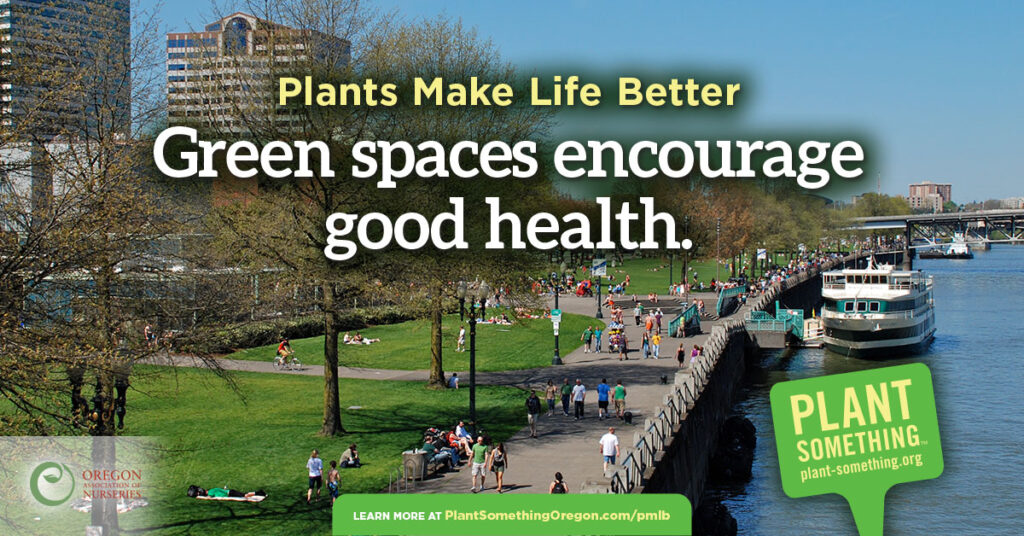
Green spaces encourage good health
- People who spend time outdoors with plants — in parks, gardens and other green spaces — benefit from increased activity, improved health, and reduced health care costs, according to one study.1
- According to the study, “Residents of neighborhoods with beautiful parks are much healthier; their increase in exercise makes them less susceptible to physical ailments and more resilient against minor illnesses.”
- “As a result, these residents do not spend as much each year on health care and medical treatment, because they require fewer of these services,” the study concluded.
- Additional research shows that outdoor activities can alleviate symptoms of Alzheimer’s disease, dementia, stress,
and depression. They can also improve cognitive function.2,3 - In addition, researchers in Scotland found that activity in green spaces impacts the incidence
of heart disease and stroke, providing evidence that green space appears to have real effects on health.4
SOURCES:
1Hall, Charles and M.W. Dickson. Economic, Environmental, and Health/Well-Being Benefits Associated with Green Industry Products and Services: A Review. Journal of Environmental Horticulture 29(2): 96–103.
2Hartig, T., M. Mang, and G. W. Evans. 1991. Restorative Effects of Natural Environment Experiences. Environment and Behavior 23.
3Taylor, A.F., F.E. Kuo, and W.C. Sullivan. 2001. Coping with ADD: The Surprising Connection to Green Play Settings. Environment and Behavior 32.
4Green spaces ‘reduce health gap’. http://news.bbc.co.uk/2/hi/health/7714950.stm.

Outdoor plants benefit businesses
- Seasonal and permanent displays of plants and flowers outside shops lend friendly, welcoming aesthetics that impact the way people feel about the quality of the products and services offered therein.
- When businesses decorate with plants, they draw in more customers who are willing to travel farther, shop longer and pay higher prices for the positive experience.
- Flowers, shrubs and trees make businesses inviting, which increases flow and puts customers at ease. Adding plants and landscape to businesses also boosts the economy by employing people to tend and maintain the displays.
- One study2 found that potential shoppers are willing to travel more often, for longer amounts of time, and over greater distances to shop in a retail district containing trees.
- Since the streetscape is an important part of creating a welcoming, interesting shopping place, trees should be part of street improvement programs that benefit businesses.
SOURCES:
1Green Cities, Good Health — http://depts.washington.edu/hhwb
2Hall, Charles and M.W. Dickson. Economic, Environmental, and Health/Well-Being Benefits Associated with Green Industry Products and Services: A Review. Journal of Environmental Horticulture 29(2): 96–103.
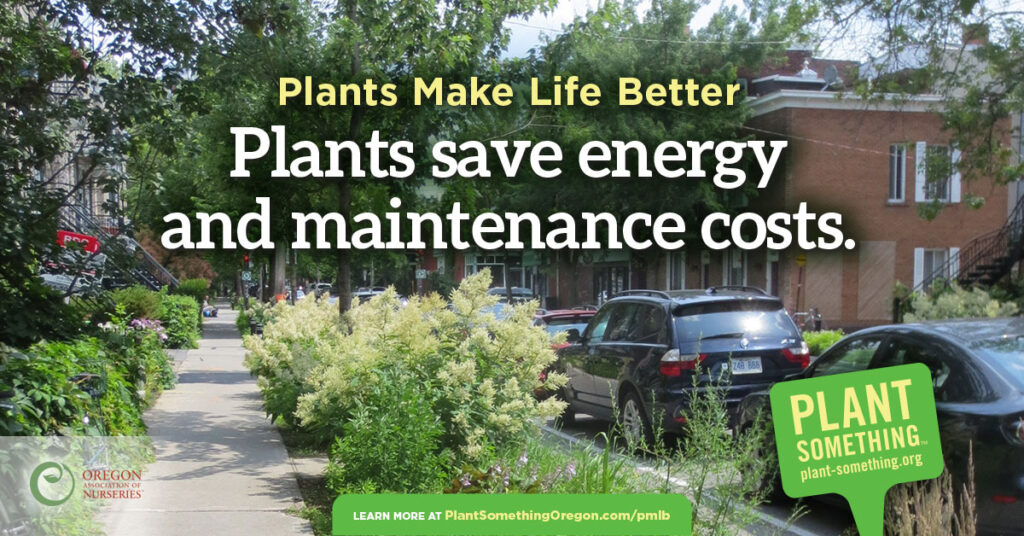
Plants save energy and maintenance costs
- Shade trees and landscaping along paved streets can cut the cost of street repairs, lower the costs of maintaining nearby buildings, and make people more comfortable by moderating the effects of the weather.
- When asphalt is exposed to the direct, intense rays of the sun, it can reach extremely high temperatures, causing it to break down more quickly and requiring more frequent repairs. One study1 has shown that protecting streets with a shady canopy cuts costs.
- Well-planned landscaping also protects buildings from the sun’s pounding rays in summer and the biting conditions of winter. Situated properly, plants can create buffers between the buildings and the elements.
- Not only does landscaping cut costs associated with cooling in summer and heating in winter, plants also protect the walls themselves, so wear and tear and the costs of upkeep are reduced.2
- By absorbing heat and sunlight, leafy trees, shrubs and other greenery reduce the reflected heat from paved surfaces and buildings, and create a more pleasant urban environment.
SOURCES:
1McPherson, E.G., & Muchnick, J. (2005). Effects of street tree shade on asphalt concrete pavement performance. Journal of Arboriculture 31:303–310.
2Hall, Charles R., & Dickson, M.W. (2011). Economic, Environmental, and Health/Well-Being Benefits Associated with Green Industry Products and Services: A Review. Journal of Environmental Horticulture 29(2):96–103.
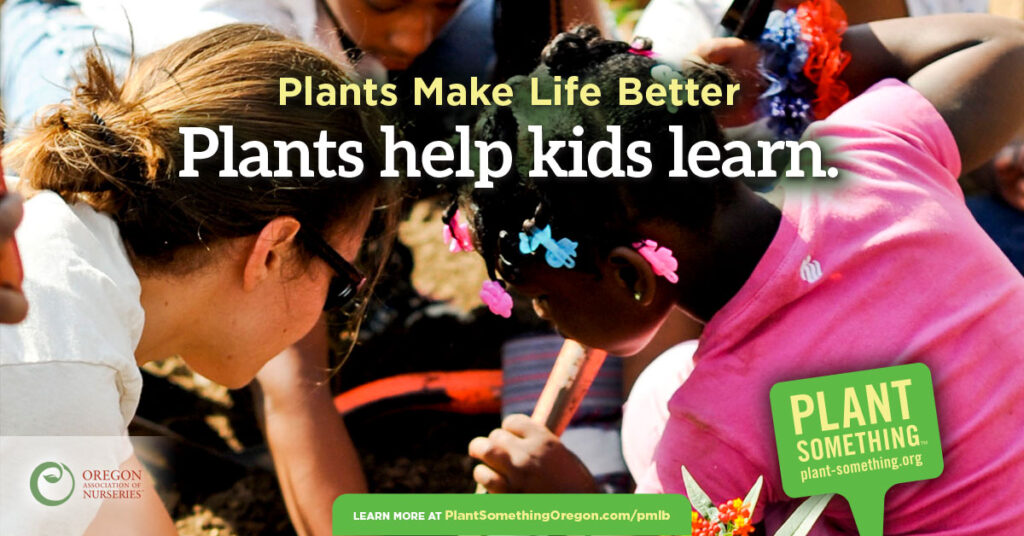
Plants help kids learn
- Studies show that exposure to plants and nature improves learning and helps kids in many important ways.
- Playing in natural settings helps develop creativity and imagination. It promotes problem solving, supports intellectual development, and enhances children’s ability to concentrate and to gain and retain new information.
- In particular, nature-based experiences support academic gains in social studies, science, language arts and math.1
- Being around plants also helps build positive social relationships and cooperation. Green settings enhance peace and promote self-control and self-discipline with inner-city youth, especially girls.
- Besides the obvious benefits of active physical play, just being in nature has been found to reduce the symptoms of attention deficit disorder (ADD), so outdoor activities can effectively supplement medicinal and behavioral treatments.2,3
Photo by Matthew Rainwater/www.realschoolgardens.org
SOURCES:
1Benefits of connecting children with nature: Why naturalize outdoor learning environments (The Natural Learning Institute, 2012).
2Hall, Charles R., & Dickson, M. W. (2011). Economic, environmental, and health/well-being benefits associated with green industry products and services: A review. Journal of Environmental Horticulture 29(2): 96–103.
3Green Cities, Good Health. Retrieved from http://depts.washington.edu/hhwb.
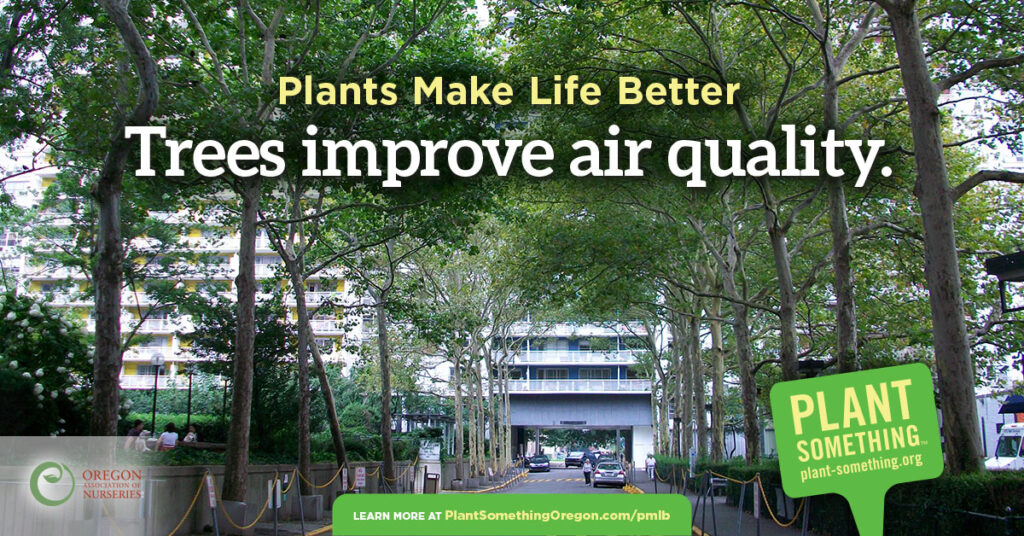
Trees improve air quality
- More than 80 percent of Americans live in urban areas, but the air in their communities contains a host of pollutants that can harm human health, from visible smog caused by motor vehicle exhaust to particulate pollution consisting of dust, dirt, pollen, ash and smoke.
- Fortunately, trees and other plants can purify the air, removing pollutants both seen and unseen. Trees catch airborne particulates with their leaves and bark, absorb gases and odors, contribute oxygen and reduce heat through respiration.
- A mature leafy tree generates as much oxygen in a single season as 10 people inhale in a year.1 Trees also release water vapor into the atmosphere through their leaves, cooling the surrounding air, which is especially important in urban areas where heat is trapped by solid surfaces.2
- Just 100 trees can remove two tons of carbon dioxide from the air annually.2 In fact, urban trees in the contiguous United States have been found to remove nearly 800,000 tons of air pollution from the atmosphere every year.
- In addition, a recent study found that green plants remove city street pollution up to eight times more than previously thought.3
By Elizabeth Petersen
Photo courtesy of www.sustainablecitiescollective.com
Sources:
1http://forestry.about.com/od/treephysiology/tp/tree_value.htm
2http://www.americanforests.org/blog/the-important-relationship-between-forests-and-air
3http://phys.org/news/2012-07-green-city-street-pollution-previously.html
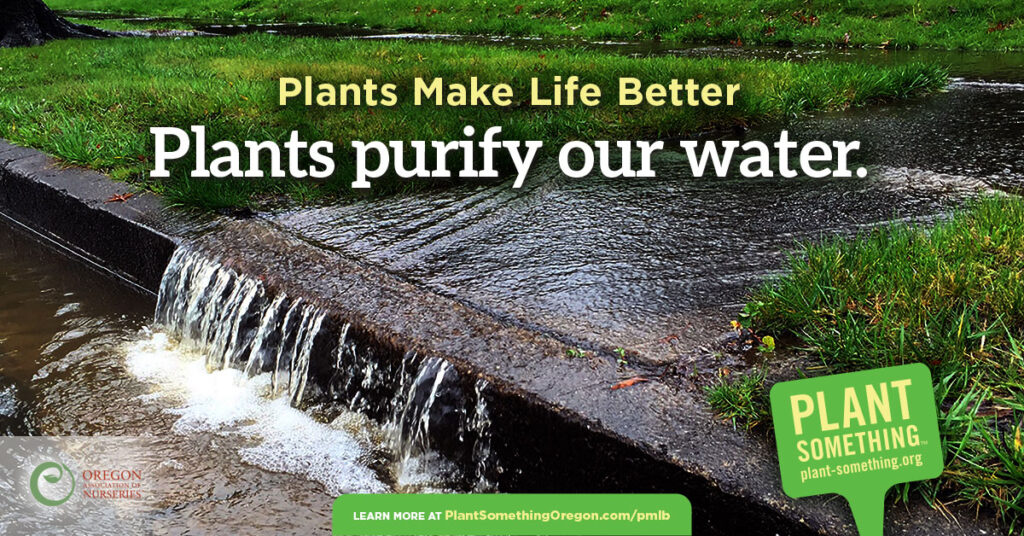
Plants purify our water
- Water is life! More than a slogan, this statement speaks to the importance of clean water on our planet.
- According to the U.S. Environmental Protection Agency, stormwater runoff is the biggest problem facing the nation’s water supply. When rain hits impervious surfaces, such as pavement and roofs, the runoff picks up contaminants and sweeps them into streams and lakes, causing pollution.
- Trees and other plants can offset this process by absorbing and recycling water into the atmosphere through transpiration. One large tree can capture and filter up to 36,500 gallons of water per year. On average, a mature tree can absorb 36 percent of the rainfall it comes in contact with.1
- Trees and other plants also anchor the soil and filter out pollutants with their roots, so fewer contaminants reach waterways.
- Water-efficient gardening — choosing plants that need less water — also helps conserve water. Native and drought-tolerant plants are a good choice because, once established, they get by on what falls from the sky.
Photo by Craig Miller/KQED
SOURCES:
1http://www.americanforests.org/explore-forests/forest-facts
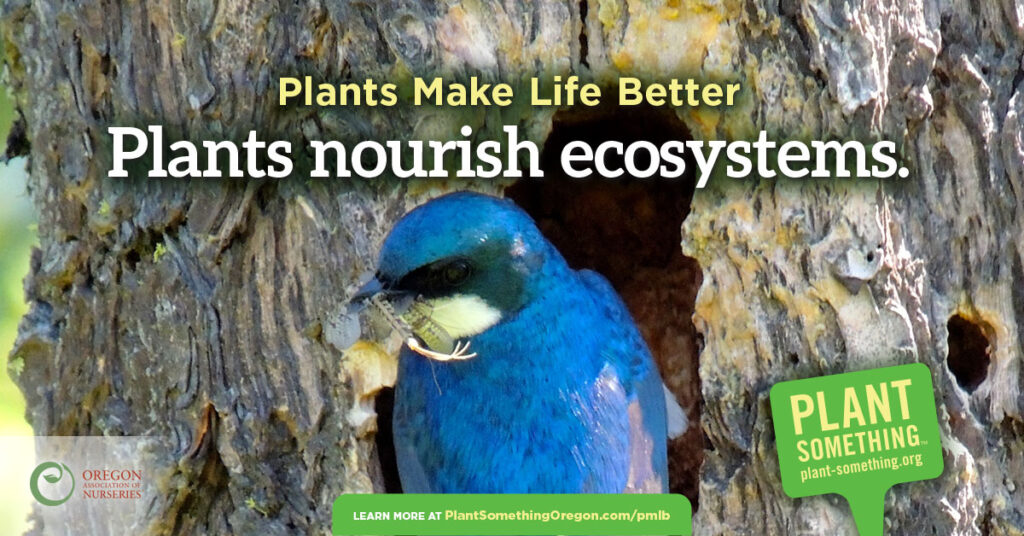
Plants nourish ecosystems
- Plants are important to healthy ecosystems. They bolster the complex networks of life and provide the essentials on which they depend — fresh water, clean air, robust soil and diverse wildlife.
- Especially in urban and suburban areas where natural ecosystems have been degraded, plants help restore nature’s diversity and sustainability. Foliage cleans the air, produces oxygen
and provides habitat and food for insects and birds. - Above ground and below, the framework provided by plants anchors, protects and feeds the soil. Plant roots support a treasure trove of organisms, from bacteria to earthworms and larger animals, all of which in turn benefit the plant.
- Roots, helped by leaves and branches, capture and filter rainwater and groundwater, removing toxins and debris. Every element of biodiversity — animal, plant and micro-organism — helps sustain key functions of the ecosystem, its structure and processes.1
- Plants are big players in the complex web of interdependent life forms, contributing essential services to humans and other organisms, and helping ensure their mutual survival.2
Photo by Rebecca Durham/Courtesy of MPGRanch.com
SOURCES:
1http://www.fao.org/agriculture/crops/thematic-sitemap/theme/biodiversity0/en
2http://www.globalissues.org/article/170/why-is-biodiversity-important-who-cares
